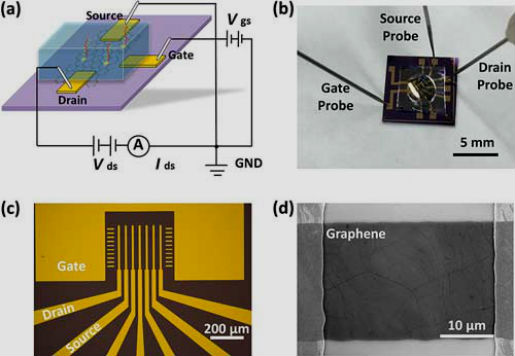|
NOVIDADES
Insulin is a rather small molecule (molecular weight 5.8 kD) and weakly charged in solution (isoelectric point 5.8) and therefore, low concentrations (<1 µM) are difficult to detect using traditional (e.g., electrochemical) methods. Current insulin detection methods are time-consuming with a low sensitivity, and are hence not adequate for rapid and direct detection of insulin at clinically appropriate concentrations. The correct and timely use of insulin is strongly dependent on accurate predictions of insulin concentrations. However, the insulin concentration in the human body is time-varying. Thus, an inline insulin detection platform is highly desirable. Conventional electrochemical and optical platforms typically operate in an off-line manner. In contrast, a novel graphene nanotechnology sensor is highly sensitive to changes in the charge distribution on and in the immediate vicinity of the graphene surface and can respond to physiological insulin concentration variations in a sensitive and rapid manner, thereby enabling real-time insulin monitoring. This graphene aptameric nanosensor, reported in ACS Applied Materials & Interfaces ("Real-Time Monitoring of Insulin Using a Graphene Field-Effect Transistor Aptameric Nanosensor"), will potentially allow real-time, highly sensitive and label-free monitoring of insulin.  Graphene nanosensor. (a) Schematic of the nanosensor configured as a solution-gated GFET. (b) Nanosensor is packaged in a PDMS chamber for liquid handling. (c) Optical micrograph of a fabricated nanosensor. (d) Scanning electron micrograph of the single-layer graphene-conducting channel in the nanosensor. Reprinted with permission by American Chemical Society
"In our work, we employed an aptamer-based graphene field-effect transistor (GFET) nanosensor for insulin detection," Qiao Lin, an Associate Professor at Columbia University, tells Nanowerk. "The GFET can rapidly respond to external stimuli such as the binding between surface-immobilized aptamer molecules with insulin, resulting in significant changes of the electrostatic charge characteristics in the close proximity of graphene surface. "This nanotechnology approach could be used in glucose-stimulated insulin release assays and holds the potential for timely and accurate prediction of insulin doses for the care of patients with Type I diabetes. The nanosensor developed by Lin and his team potentially provides a platform to exploit G-quadruplex conformation-switching signaling as the principle in a graphene electronic nanodevice to enable real-time monitoring of insulin at physiologically relevant concentrations – down to approximately 35 pM. "We envision that our graphene aptameric nanosensor can ultimately be used for inline real-time detection of insulin in glucose-stimulated insulin release assays in clinical care and research in insulin-dependent diabetes, such as enabling artificial pancreas systems as well as studies of islet xenotransplantation," notes Lin. Going forward, the team plans to test the nanosensor for detection of insulin in supernatant samples from pancreatic islet Beta cell secretion in vitro. The research reported in this paper directly targets artificial pancreas systems in diabetes care and can be potentially extended to other wearable or implantable systems in clinical diagnostics and therapeutics. The realization of this potential requires major challenges to be addressed. For example, the nanosensors need to be integrated on platforms that are mechanically flexible as well as biologically compatible, so as to conform to nonplanar human body or organ surfaces with minimized irritation or toxicity effects to the surrounding tissue. It will also be important to understand and minimize the effects of nonspecific adsorption of background molecules on functional nanomaterials such as graphene when the nanosensors are deployed in physiological fluids. However, development of this nanosensor is in infancy and much research still needs to be done before the device can be used in clinical settings. For example, molecular interactions on the graphene surface need to be thoroughly investigated so that the nanosensor responds to insulin concentration variations in a fully reversible and specific manner. "Ultimately, we envision that our nanosensor will be used in artificial pancreas systems for Type I diabetes management, as well as other clinical and therapeutic systems," concludes Lin. By Michael Berger. Posted: Aug 30, 2017. Assuntos Conexos: |
|||||||||||||||||||||||||